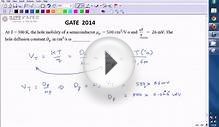This article needs attention from an expert in Physics. Please add a reason or a talk parameter to this template to explain the issue with the article. WikiProject Physics (or its Portal) may be able to help recruit an expert.
Diffusion current is a current in a semiconductor caused by the diffusion of charge carriers (holes and/or electrons). The drift current, by contrast, is due to the motion of charge carriers due to the force exerted on them by an electric field. Diffusion current can be in the same or opposite direction of a drift current. The diffusion current and drift current together are described by the drift–diffusion equation.
It is necessary to consider the diffusion current when describing many semiconductor devices. For example, the current near the depletion region of a p–n junction is dominated by the diffusion current. Inside the depletion region, both diffusion current and drift current are present. At equilibrium in a p–n junction, the forward diffusion current in the depletion region is balanced with a reverse drift current, so that the net current is zero.
The diffusion constant for a doped material can be determined with the Haynes–Shockley experiment. Alternatively, if the carrier mobility is known, the diffusion coefficient may be determined from the Einstein relation on electrical mobility.
Diffusion current versus drift current[edit]
The following table compares the two forms of current:
| Drift current | |
|---|---|
| Diffusion current may occur even if there isn't an electric field in the semiconductor. | Drift current requires an the electric field to be present. |
| The magnitude of the diffusion current depends on the slope of the carrier concentration, and not the concentration itself. | The magnitude depends on the carrier concentration. |
| Direction of the diffusion current depends on the slope of the carrier concentration, and not the concentration itself. | Direction of the drift current is always in the direction of the electric field. |
| Does not obey Ohm's law | Obeys Ohm's law |
Carrier actions[edit]
No external electric field across the semiconductor is required for a diffusion current to take place. This is because diffusion takes place due to the change in concentration of the carrier particles and not the concentrations themselves. The carrier particles, namely the holes and electrons of a semiconductor, move from a place of higher concentration to a place of lower concentration. Hence, due to the flow of holes and electrons there is a current. This current is called the diffusion current. The drift current and the diffusion current make up the total current in the conductor. The change in the concentration of the carrier particles develops a gradient. Due to this gradient, an electric field is produced in the semiconductor.
Derivation[edit]
Some or all of the formulas presented in this article have missing or incomplete descriptions of their variables, symbols or constants which may create ambiguity or prevent full interpretation. Please assist in recruiting an expert or improve this article yourself. See the
RELATED VIDEO

